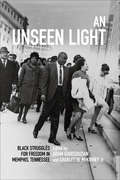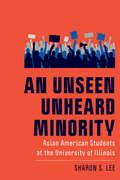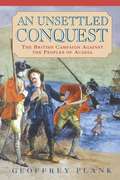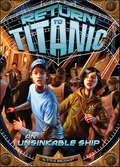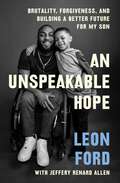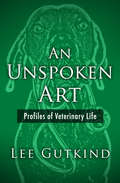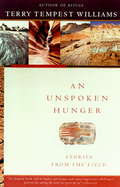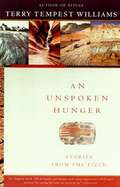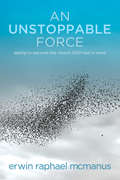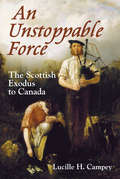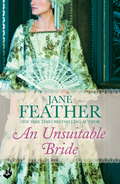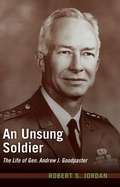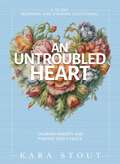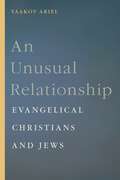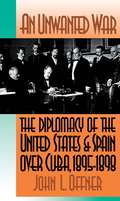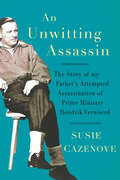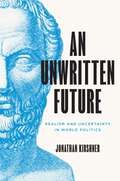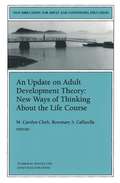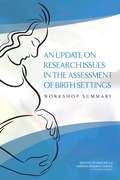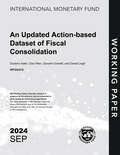- Table View
- List View
An Unseen Light: Black Struggles for Freedom in Memphis, Tennessee (Civil Rights and the Struggle for Black Equality in the Twentieth Century)
by Aram Goudsouzian and Charles W. McKinneyScholars examine the activist efforts of Black Americans in Memphis in a series of essays ranging from the Reconstruction era to the twenty-first century.In An Unseen Light: Black Struggles for Freedom in Memphis, Tennessee, eminent and rising scholars present a multidisciplinary examination of African American activism in Memphis from the dawn of emancipation to the twenty-first century. Together, they investigate episodes such as the 1940 “Reign of Terror” when Black Memphians experienced a prolonged campaign of harassment, mass arrests, and violence at the hands of police. They also examine topics including the relationship between the labor and civil rights movements, the fight for economic advancement in Black communities, and the impact of music on the city’s culture. Covering subjects as diverse as politics, sports, music, activism, and religion, An Unseen Light illuminates Memphis’s place in the long history of the struggle for African American freedom and human dignity.Praise for Unseen Light“From the aftermath of the post-Civil War race massacre to continuous violence, murder, and bitter confrontations into the twenty-first century, contributors illuminate An Unseen Light on those Black Memphians forging lives nonetheless, through negotiation, protest, music, accommodation, prayer, faith and sometimes sheer stubbornness . . . . Scholars intellectually and personally invested in the city as a site of family and community, and career, bring an unequivocal depth of understanding and richness about place and belonging that textures the pages with life, from the church pews, the music studios, or the myriad of social or political organizations, to the land itself, adding more layers to underscore how black lives have mattered in the historical grassroots building of the nation. This is thoughtful and beautiful work.” —Françoise Hamlin, author of Crossroads at Clarksdale: The Black Freedom Struggle After World War II“This rich collection covers a broad range of topics pertaining to the African American freedom struggle in Memphis, Tennessee. One of its greatest strengths is the breadth of the essays, which span a long period from the end of the Civil War to the twenty-first century. An Unseen Light is a valuable addition to civil rights scholarship.” —Cynthia Griggs Fleming, author of Yes We Did?: From King's Dream to Obama's Promise“The collection did an excellent job in explaining the inner workings of Memphis . . . . The works highlighted the past actions, organizing and insurgency which created the dynamics of racism, classism, social, and political power seen in modern Memphis. I recommend this collection to those interested in the shaping of a large southern city. I also recommend to new and lifelong Memphians to provide a blueprint of the historical legacy of Memphis and how this legacy continues to impact the lives of African Americans.” —Tennessee Libraries
An Unseen Unheard Minority: Asian American Students at the University of Illinois (New Directions in the History of Education)
by Sharon S. LeeHigher education hails Asian American students as model minorities who face no educational barriers given their purported cultural values of hard work and political passivity. Described as “over-represented,” Asian Americans have been overlooked in discussions about diversity; however, racial hostility continues to affect Asian American students, and they have actively challenged their invisibility in minority student discussions. This study details the history of Asian American student activism at the University of Illinois Urbana-Champaign, as students rejected the university’s definition of minority student needs that relied on a model minority myth, measures of under-representation, and a Black-White racial model, concepts that made them an “unseen unheard minority.” This activism led to the creation on campus of one of the largest Asian American Studies programs and Asian American cultural centers in the Midwest. Their histories reveal the limitations of understanding minority student needs solely along measures of under-representation and the realities of race for Asian American college students.
An Unsettled Conquest: The British Campaign Against the Peoples of Acadia (Early American Studies)
by Geoffrey PlankThe former French colony of Acadia—permanently renamed Nova Scotia by the British when they began an ambitious occupation of the territory in 1710—witnessed one of the bitterest struggles in the British empire. Whereas in its other North American colonies Britain assumed it could garner the sympathies of fellow Europeans against the native peoples, in Nova Scotia nothing was further from the truth. The Mi'kmaq, the native local population, and the Acadians, descendants of the original French settlers, had coexisted for more than a hundred years prior to the British conquest, and their friendships, family ties, common Catholic religion, and commercial relationships proved resistant to British-enforced change. Unable to seize satisfactory political control over the region, despite numerous efforts at separating the Acadians and Mi'kmaq, the authorities took drastic steps in the 1750s, forcibly deporting the Acadians to other British colonies and systematically decimating the remaining native population.The story of the removal of the Acadians, some of whose descendants are the Cajuns of Louisiana, and the subsequent oppression of the Mi'kmaq has never been completely told. In this first comprehensive history of the events leading up to the ultimate break-up of Nova Scotian society, Geoffrey Plank skillfully unravels the complex relationships of all of the groups involved, establishing the strong bonds between the Mi'kmaq and Acadians as well as the frustration of the British administrators that led to the Acadian removal, culminating in one of the most infamous events in North American history.
An Unsinkable Ship
by Steve BrezenoffAfter Tucker and Maya are jolted back to the present by Titanic's iceberg collision, they don't know what will happen to their new friend, Liam, who is still trapped onboard. They travel back to 1912 again to make sure Liam and his parents, all third-class passengers, make it to the lifeboats in time. But none of the passengers seem to realize the severity of the situation. Tucker and Maya must convince everyone that the unsinkable ship is sinking, and find Liam, before it's too late.
An Unspeakable Hope: Brutality, Forgiveness, and Building a Better Future for My Son
by Leon FordA &“powerful and insightful&” (Cyntoia Brown-Long, author of Free Cyntoia) memoir in the vein of Just Mercy and The Sum of Us that upends our understanding about the future of policing in the United States and explores how we can begin healing from systemic injustice.In 2012, nineteen-year-old Leon Ford was shot five times by a Pittsburgh police officer during a racially charged traffic stop stemming from a case of mistaken identity. When he woke up in the hospital, he was faced with two life-changing realities: he was a new father, and he was paralyzed from the waist down. Leon found the only way to move forward was to let go of his bitterness and learn to practice forgiveness. Now, in this memoir and manifesto, Leon illustrates how this harrowing experience has inspired a deep reckoning with the issues his community is facing, not only with police brutality, but also an epidemic of street violence, toxic masculinity and its impact on Black fatherhood, and the lack of disability rights and mental health access in disenfranchised communities. In the wake of countless similar shootings across the country, Leon details how he turned towards social activism, dedicating himself to bridging the gap between the police and the communities they are supposed to serve. With a voice filled with &“healing, triumph, and resilience&” (Shaka Senghor, bestselling author of Writing My Wrongs), Ford offers fresh, counterintuitive ways we can effect social change. Leon shows us how, together, we can move away from retribution and towards transformative justice in order to end police brutality and heal as a country. As he once said, &“Lead with love. Start compassionate conversations even with individuals and systems that have caused you pain. I know from experience that you can make your pain purposeful.&”
An Unspoken Art: Profiles of Veterinary Life
by Lee GutkindIn the tradition of James Herriot&’s All Creatures Great and Small, An Unspoken Art is Lee Gutkind&’s captivating look at the lives of veterinarians, from the zoos to the farmLee Gutkind, the godfather of creative nonfiction, explores with warmth and sincerity the worlds of modern-day veterinarians—from practitioners operating on Manhattan&’s Upper East Side to those working knee deep in mud in the English countryside. Gutkind profiles the men and women who have devoted their lives to the care of animals, almost all treating their patients with more humanity and compassion than physicians in human hospitals do. He writes of the people who do not bat an eye at sharing a bed with their dogs, and of those who spare no expense when it comes to the well-being of their pets.An Unspoken Art is an insightful look at the individuals who dedicate themselves to the care of creatures, and of the enduring bond between people and animals.
An Unspoken Hunger
by Terry Tempest WilliamsWilliams weaves her observations in the naturalist field and her personal experience--as a woman, a Westerner, and a Mormon--into a resonant manifesto on behalf of the landscapes she loves, making clear as well that, through our disregard of this world, we have lost an essential connection to our deepest selves.
An Unspoken Hunger: Stories from the Field
by Terry Tempest WilliamsWilliams weaves her observations in the naturalist field and her personal experience--as a woman, a Westerner, and a Mormon--into a resonant manifesto on behalf of the landscapes she loves, making clear as well that, through our disregard of this world, we have lost an essential connection to our deepest selves.
An Unstoppable Force
by Erwin Raphael McmanusAs the world around us changes at record-speed, An Unstoppable Force imagines a church that embraces change by remaining fully committed to its apostolic calling. Church leaders will discover new ways of engaging communities through vibrant, relevant ministries and clear, innovative communication. An Unstoppable Force challenges churches to cast aside methods that are broken or atrophied and embrace the future of the Church with vigor. McManus's prophetic voice outlines a church that is not a refuge from the world, but a refuge to the world. Christians on the forefront of the church movement must be ready to let go of the past and move forward.
An Unstoppable Force: The Scottish Exodus to Canada
by Lucille H. CampeyThis book provides the first exhaustive study of the great Scottish exodus to Canada written in modern times. Using wide-ranging sources, some previously untapped, Lucille Campey examines the driving forces behind the Scottish exodus and traces the remarkable progress of Scottish colonizers across Canada. Mythology and truth are considered side by side as their story unfolds. Scots had a profound impact on Canada and shaped the course of its history. This book is essential reading for those who wish to understand why they came and the enormity of their achievements in Canada.
An Unsuitable Bride
by Jane FeatherLong ago, young Viscount Bradley's prudish family forbade him to marry his beloved. Now, the aging lord has plotted a subtle revenge. His three nephews can split his fortune, but only if each marries a fallen woman. Two have found brides who meet the terms . . . and all depends on the youngest, Peregrine Sullivan. New York Times bestselling author Jane Feather's Georgian trilogy concludes with a sexy tale sure to delight. Only desperation would drive a lady to disguise herself in hopes of employment, but the twenty thousand pounds that their father promised beautiful Alexandra Douglas and her invalid younger sister has vanished into the hands of the greedy cousin who inherited the estate. Alexandra, in search of justice, embarks on an elaborate charade to infiltrate Combe Abbey, her ancestral home, and secretly take the money back. Peregrine, visiting the Abbey, is intrigued by a woman whose mind matches his on every level. Who is this middle-aged spinster with a young woman's eyes and a youthful step that even a limp cannot disguise? Sensing some scandalous secret, Perry assumes the lady would delight in being rescued. But his efforts are rebuffed; Alexandra will take care of herself and her sister, thank you very much. Can Perry court the daring and independent young woman, win her heart, and be the last brother to wed?
An Unsuitable Bride: Blackwater Brides Book 3 (Blackwater Brides Series)
by Jane FeatherIf you love Poldark, you'll love Jane Feather's dazzling Georgian romantic trilogy, the Blackwater Brides, which concludes with An Unsuitable Bride.Perfect for fans of Eloisa James, Liz Carlyle and Stephanie Laurens.Only desperation would drive a lady to disguise herself in hopes of employment, but the twenty thousand pounds that their father promised beautiful Alexandra Douglas and her invalid younger sister has vanished into the hands of the greedy cousin who inherited the estate. Alexandra, in search of justice, embarks on an elaborate charade to infiltrate Combe Abbey, her ancestral home, and secretly take the money back. Peregrine, visiting the Abbey, is intrigued by a woman whose mind matches his on every level. Who is this middle-aged spinster with a young woman's eyes and a youthful step that even a limp cannot disguise? Sensing some scandalous secret, Perry assumes the lady would delight in being rescued. But his efforts are rebuffed; Alexandra will take care of herself and her sister, thank you very much. Can Perry court the daring and independent young woman, win her heart, and be the last brother to wed?Follow the stories of Perry's dashing brothers in Rushed to the Altar and A Wedding Wager, or check out Jane Feather's tantalising spy versus counterspy tale in Twelfth Night Secrets.
An Unsung Soldier
by Robert S. JordanGen. Andrew J. Goodpaster was one of the leading soldier-scholars of his time. He was one of the key figures during the Cold War - one who stood among the dominant American military and political personalities of those times. Goodpaster served Gen. Dwight Eisenhower in establishing the international military component of NATO and then served as his Staff Secretary. He achieved the highest international military command assignment possible - as NATO's Supreme Allied Commander, Europe and restored the integrity of West Point during a major ethical crisis. Upon his final retirement and for over a quarter-century thereafter, he was actively involved both the formal and informal world of Washington policy-making, making his mark repeatedly as a respected participant.
An Untold Story (The Roosevelts of Hyde Park)
by James Brough Elliott RooseveltRecently, I became increasingly perturbed over a twisting of facts which has led far too many people to regard Father as a cardboard puppet, manipulated by anyone with the urge to try, dependent on Mother for strength and wisdom. She, in turn, is looked upon as a latter-day Joan of Arc, incapable of error or sin. Neither portrait contains the faintest element of truth. Mother, whose idolaters are largely responsible for this mangling of the record of yesterday, would have been among the first to acknowledge that.
An Untroubled Heart
by Micca CampbellMicca Campbell knows all too well the unpredictable nature of life. As the 21-year-old mother of an infant son, her world was shattered when she lost her husband to a tragic accident. Reeling from her loss, Micca feared for her future, and struggled to overcome her aching loneliness. Yet in her darkest moment, she discovered God's remedy for our deepest fears. Micca presents a woman's guide for living a carefree, worry-free life. She explores the anxieties of every woman's heart from insecurities, to finances, to marital challenges, to raising healthy children. With her distinctive southern flair and casual humor, Micca shares remarkable insights for finding freedom from fear. You'll be encouraged to lay down your worries, trust in your Heavenly Father, and embrace a life marked by peace and joy. Bible Study Questions at the end of each chapter.
An Untroubled Heart: Calming Anxiety and Finding God's Peace (A 30-Day Morning and Evening Devotional)
by Kara StoutBegin your day in God's comforting presence and end your day in His calming embrace. This unique 30-day devotional reminds you that God is greater than your troubled heart and more present than your anxious thoughts.Whether you are stressed in the morning about the day ahead or desperate to calm your mind in the evening before bed, peace often feels elusive—and sometimes God does too. But even in the midst of life's uncertainties, God is ever present and ready to offer His comfort, if only you seek Him.In An Untroubled Heart, author Kara Stout offers 30 morning devotions to carry you through the day and 30 companion evening devotions to settle your heart at night. Let your soul breathe in peace as you…Bookend your day with bite-sized reflections and prayers that meet you where you are.Grow in your relationship with God and build a habit of coming to Him in prayer.Realize you are not alone in your feelings of worry and overwhelm.Strengthen your faith day by day as you immerse yourself in God's truth. The deep peace you crave is available, no matter what your anxious thoughts are telling you. Come experience the truth of Scripture, the comfort of the Spirit, and the kind of rest that only a good and perfect Father can give.
An Unusual Midwife: An Uplifting Medical Romance (Medical Romances #5)
by Gill SandersonAnother heartwarming medical romance from best-selling author Gill Sanderson! Perfect for fans of Mia Faye, Laura Scott, Helen Scott Taylor, Grey's Anatomy and ER.Readers love Gill's gripping medical romances!'Excellent story could not put it down' 5* reader review'...a very romantic story. I enjoyed every part of this book' 5* reader review'...another very well written book... you cannot put it down' 5* reader reviewBeing a male midwife is an unusual career choice for an Ex-army officer. But Chris McAlpine has chosen it - and he is good at it. At first his new boss, Joy Taylor, is suspicious of Chris. But in time she recognises his dedication to the job and admires his organisational skills as well. It doesn't take long before she starts to develop feelings for the man, and to her delight, Chris feels the same way.However, Chris has a problem. A wound from the past has left him with the inability to father children. He knows he has to tell Joy - as she wants children. However they decide to stay together and see how things work out. Then the unimaginable happens and suddenly Joy hates Chris. It takes all his military skills - and some help from his father - for Chris to put things right.Don't miss Gill Sanderson's enthralling medical romances, including the A Lakeland Practice and the Good, Bad and Ugly series.
An Unusual Relationship: Evangelical Christians and Jews (Goldstein-Goren Series in American Jewish History #12)
by Yaakov ArielItis generally accepted that Jews and evangelical Christians have little incommon. Yet special alliances developedbetween the two groups in the nineteenth and twentieth centuries. Evangelicalsviewed Jews as both the rightful heirs of Israel and as a group who failed torecognize their true savior. Consequently, they set out to influence the courseof Jewish life by attempting to evangelize Jews and to facilitate their returnto Palestine. Their double-edged perception caused unprecedented political,cultural, and theological meeting points that have revolutionizedChristian-Jewish relationships. An Unusual Relationship explores thebeliefs and political agendas that evangelicals have created in order to affectthe future of the Jews. Additionally, it analyses Jewish opinions and reactionsto those efforts, as well as those of other religious groups, such as ArabChristians.Thisvolume offers a fascinating, comprehensive analysis of the roots,manifestations, and consequences of evangelical interest in the Jews, and thealternatives they provide to conventional historical Christian-Jewishinteractions. It also provides a compelling understanding of Middle Easternpolitics through a new lens.
An Unwanted War
by John L. OffnerOffner clarifies the complex relations of the United States, Spain, and Cuba leading up to the Spanish-American War and contends that the war was not wanted by any of the parties but was nonetheless unavoidable. He shows that a final round of peace negotiations failed in large part because internal political constraints limited diplomatic flexibility.
An Unwitting Assassin
by Susie Cazenove9 April 1960 was the day that changed Suzie Cazenove’s life, it was the day her father, David Pratt, shot the Prime Minister of South Africa, Dr Hendrik Verwoerd. Verwoerd, commonly known as the architect of apartheid, didn’t die, but Pratt’s family lived with the legacy of his action. A chance encounter with the late David Rattray of Fugitive’s Drift led Cazenove to revisit the memories of that terrible day. With Rattray’s encouragement she put pen to paper to describe the extraordinary events of that day and its consequences. Part family memoir, part ode to the settlement of Johannesburg, Cazenove skilfully weaves her family history and the mood in South Africa in the 1950s and 60s as a background to what may have led her father, a farmer and gentle man, to commit a treasonous act. Some of the facts went to the grave with her father, leaving the family with many questions.
An Unwritten Future: Realism and Uncertainty in World Politics (Princeton Studies in International History and Politics #186)
by Jonathan KirshnerAn argument for the classical realist approach to world politics An Unwritten Future offers a fresh reassessment of classical realism, an enduring approach to understanding crucial events in the international political arena. Jonathan Kirshner identifies the fundamental flaws of classical realism&’s would-be successors and shows how this older, more nuanced and sophisticated method for studying world politics better explains the formative events of the past. Kirshner also reveals how this approach is ideally equipped to comprehend the vital questions of the present—such as the implications of China&’s rise, the ways that social and economic change alter the balance of power and the nature of international conflict, and the consequences of the end of the US-led postwar order for the future of world politics.Laying out realism&’s core principles, Kirshner discusses the contributions of the perspective&’s key thinkers, including Thucydides, Hans Morgenthau, and Raymond Aron, among others. He illustrates how a classical realist approach gives new insights into major upheavals of the twentieth century, such as Britain&’s appeasement of Nazi Germany and America&’s ruinous involvement in Vietnam. Kirshner also addresses realism&’s limits and explores contemporary issues, including the ascent of great power challengers, the political implications of globalization, and the diffusion of power in modern world politics.A reexamination of the realist tradition, with a renewed emphasis on the crucial roles played by uncertainty, contingency, and contestation, An Unwritten Future demonstrates how a once-popular school of thought provides invaluable insights into pressing real-world problems.
An Update on Adult Development Theory: New Ways of Thinking About the Life Course
by M. Carolyn Clark Rosemary S. CaffarellaOur approach to adult learners and the learning process is shaped by our knowledge of how adults change and develop across the life span. This issue of New Directions for Adult and Continuing Education reviews the latest work in adult developmental theory in the biological, psychological, sociocultural, and integrated domains, and explores the implications of this work for adult education. Chapters examine how gAnder, race, and sexual orientation affect our sense of self; explore spiritual development and theories of aging; and offer a way of understanding development in terms of how people use narrative to organize and make meaning of their experiences. This is the 84th issue of the quarterly journal New Directions for Adult and Continuing Development.
An Update on Anxiety Disorders: Etiological, Cognitive & Neuroscientific Aspects
by Marwa AzabThis book aims to synthesize recent theoretical and experimental findings from psychology, neuroscience, epigenetics and genetics to understand anxiety disorders and their etiology and treatments. Each anxiety disorder is discussed from cognitive, behavioral and biological perspectives. The book evaluates talk therapies, mindfulness-based interventions, brain stimulation, biofeedback and neurofeedback treatments. Chapters consider a biologically-informed framework for the understanding of anxiety disorders. In line with current thinking, the book integrates many levels of information (from genomics and circuits to behavior and self-report) to understand normal and abnormal human behaviors. Synthesizing recent research on anxiety disorders according to their categorization in the DSM5, this book will bring psychology students, researchers, psychiatrists and psychologists up to date.
An Update on Research Issues in the Assessment of Birth Settings
by Institute of Medicine National Research Council Board on Children, Youth, and Families Leslie PrayMore than 30 years ago, the Institute of Medicine (IOM) and the National Research Council (NRC) convened a committee to determine methodologies and research needed to evaluate childbirth settings in the United States. The committee members reported their findings and recommendations in a consensus report, Research Issues in the Assessment of Birth Settings (IOM and NRC, 1982). An Update on Research Issues in the Assessment of Birth Settings is the summary of a workshop convened in March, 2013, to review updates to the 1982 report. Health care providers, researchers, government officials, and other experts from midwifery, nursing, obstetric medicine, neonatal medicine, public health, social science, and related fields presented and discussed research findings that advance our understanding of the effects of maternal care services in different birth settings on labor, clinical and other birth procedures, and birth outcomes. These settings include conventional hospital labor and delivery wards, birth centers, and home births. This report identifies datasets and relevant research literature that may inform a future ad hoc consensus study to address these concerns.
An Updated Action-based Dataset of Fiscal Consolidation
by LeighA report from the International Monetary Fund.
